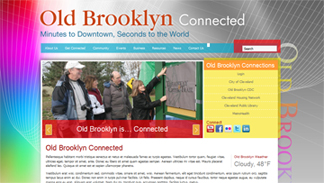Broadband 101: Utilization Drives Impact
Earlier this month Derek Murphy, SNG’s VP of Project Delivery, and I attended the Rural TeleCon Conference in Arizona – put on by the Rural Telecommunications Congress (RTC). The RTC describes itself as a “national membership organization dedicated to assuring that rural areas in the United States have access to the information and support they need to obtain and use advanced telecommunications services and technology for social and economic development.”
 Leaders of regional broadband initiatives from across the United States gathered to discuss the challenges and opportunities they face in 2011 and beyond. Representatives from approximately 25 states expressed that while their opportunities (driven in large part by broadband stimulus) are significant – the challenges accompanying them seemed to be overwhelming to most. A key discussion topic at the conference was around looking for ways to leverage broadband for regional development.
Leaders of regional broadband initiatives from across the United States gathered to discuss the challenges and opportunities they face in 2011 and beyond. Representatives from approximately 25 states expressed that while their opportunities (driven in large part by broadband stimulus) are significant – the challenges accompanying them seemed to be overwhelming to most. A key discussion topic at the conference was around looking for ways to leverage broadband for regional development.
From my perspective, there was a sea-change in the broadband discussion because of this focus on regional development. Beyond the “supply-side” of broadband, people started taking a serious look at the “demand-side” of the broadband equation. It’s the utilization that drives impact and benefits.
Hilda Legg, a former RUS administrator, noted in her keynote that it is imperative to the success of broadband initiatives is moving away from “business as usual” where telcos drive infrastructure build-out according to population and instead look to where utilization and accompanying impacts are the most significant.
So how do you overcome this? How do you help to ensure that your hefty investment has an even “heftier” impact? Step one? “Identify needs, gaps, and demand.” Much of the broadband stimulus allocation was based on “gaps” and “needs” – areas that are under or un-served. But this does not ensure use – unlike “Field of Dreams,” building broadband does not ensure people will come.
Instead of building a baseball field in a cornfield, make sure that you map demand – benchmark utilization of e-solutions throughout your region to uncover where the deepest and most long-lasting impacts will occur.
This exercise will not only help you know areas most likely to adopt broadband, it has the added benefit of driving awareness among businesses, organizations, and households. So what? Well this helps to drive adoption, application development, and ultimately the economic and social impacts of the network.
Washington’s State’s Broadband Policy and Programs Manager Angela Wu summed it up best: “Don’t just map supply, map demand too!”
SNG’s Michael Curri Appointed to RTC Board
 At the annual conference, SNG president Michael Curri was appointed to the Rural Telecommunications Congress Board.
At the annual conference, SNG president Michael Curri was appointed to the Rural Telecommunications Congress Board.
“We’re thrilled to be part of the RTC as we’re extremely excited about the direction the organization is moving,” says Curri. “SNG looks forward to helping organizations understand how to map demand to leverage broadband investments for maximum impact.”
Collaboration Means Cost Savings for You!
Identifying demand is just the first step to ensuring success along the Broadband Lifecycle.
As you move to planning and strategy (steps 2 and 3), benchmarking utilization of broadband and e-solutions uncovers synergies and potential partnerships to share in e-solutions investments. This can be among government entities, organizations, or industries with shared goals and interests. The key is that drivers for change be identified and quantified in terms of impacts and benefits that each stakeholder group can expect by committing to a collaborative project.In the US, there is a unusual paradigm many regions face as they receive heavy investment in the form of broadband stimulus – while at the same time are seeing their operating budgets slashed and pressure to reduce staff.
States investing in broadband can have an even greater impact by finding areas where collaboration amongst different stakeholders on innovative uses of broadband applications makes sense.
A widespread broadband deployment offers a chance for every organization to examine how they currently deliver services. Broadband offers the opportunity to improve service, extend reach, and increase the scale and scope of efficiencies – all critical in today’s fast-paced (and budget cutting) world.
SNG Facts: SNG’s 2010 survey of County and Municipal governments in the State of North Carolina reveals that 75% of county and municipal governments view the opportunity to reduce costs and increase efficiencies as a very important motivation for adopting e-solutions, while 56% see this as an opportunity to undertake collaborative initiatives with other organizations. However, only 19% are currently collaborating with other organizations on the provision of shared services with another 12% actively considering such collaboration.
The current economic downturn and the severe budget reductions that governments at all levels are facing is a ‘burning platform’ and an opportunity for breaking down existing silos and changing cultures towards sharing infrastructure and services. With responsible spending and efficiencies a front and center concern, now is the time to change how services are delivered. SNG’s e-Solutions Benchmarking can help you identify where the opportunities for collaboration are – and where the most immediate and significant impacts lie. Without clear insights, trying to drive collaboration is a little like trying to boil the ocean… theoretically possible, but practically unachievable.
How do you communicate “sharing” broadband infrastructure with potential partners and citizens? Start by asking – does it make sense that each airline have their own airport? An American Airlines airport, a Continental airport, etc. would all be required had the airlines not agreed long ago that sharing infrastructure – even with their competitors – was the most efficient way to leverage infrastructure and deliver quality service.
SNG’s experience has consistently pointed to and developed strategies for collaboration with quantifiable benefits that double the investment. And as our recent study in North Carolina shows, citizens are poised for collaboration, efficiencies, and change. This is the time – how will you capture the opportunities for your region?
Making a “New” Old Brooklyn
by Jim Nice
Northeast Ohio continues to be recognized globally as a model of regional broadband implementation as the Intelligent Community Forum (ICF) once again tabbed it as one of their 21 global “smart communities.”Part of the ongoing efforts in the Cleveland area to separate the region from competitors includes the Northeast Ohio Broadband Coalition (NEOBC). This organization is bringing together stakeholders and vendors involved in both access technologies/hardware with those that develop content and applications to revitalize a West side neighborhood of Cleveland called Old Brooklyn.
Cleveland Councilman Kevin Kelly parlayed a number of financial resources and spearheaded by the local community development corporation, the Old Brooklyn neighborhood is in the early stages of deploying a wireless broadband infrastructure. His vision is a neighborhood that will attract and retain business while utilizing the Internet to enhance the attractiveness of the community and its workforce – while at the same time serving as a model for other Cleveland neighborhoods.

- Community Engagement: forming “communities of interest” around major broadband application areas to align expectations, resources and applications – education, health care, economic development, seniors, arts & culture, public safety, the underserved, utility usage.
- Application Development: assembling a team of individuals and companies to work on developing and discovering applications, content, services & products to deploy on the network. In addition a local support team will anchor a storefront in Old Brooklyn, as the first occupant of a business incubator.
- Communications: working with OBCDC to integrate the network – and its new tool set – into their communication strategies both internal to the neighborhood and externally to other constituencies. Expanding the news function of neighborhood publication “Old Brooklyn News” into a “community information portal.”
- Training: developing effective “digital literacy” programs that target local citizens and organizations. Adoption and usage of the network – driven by worthwhile applications – is the only way that its true benefits can be realized.
A holistic approach that embraces collaboration is a fundamental platform for success. A coalition representatives of every aspect of citizenry is involved in Old Brooklyn’s course of action – from residents to organizations, companies and associations sure to be impacted by access to a ubiquitous broadband network. This includes education, health care, senior citizens, public safety, utilities, community groups, economic development professionals and more. By focusing on stakeholder needs, Old Brooklyn demonstrates how focusing on awareness and adoption is a model that can be replicated throughout each of the cities and the rest of the region.
As always, thank you for your continued support. If you have any questions or feedback, please don’t hesitate to get in touch!

